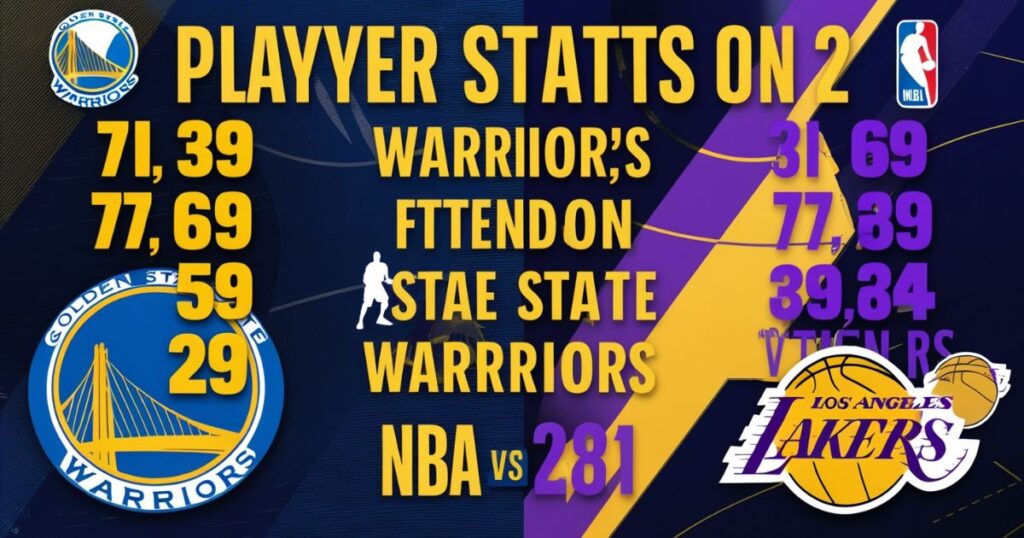Introduction to Golden State Warriors vs Lakers Match Player Stats
The rivalry between the Golden State Warriors and the Los Angeles Lakers stands as one of basketball’s most electrifying matchups. These two West Coast powerhouses have consistently delivered memorable games filled with statistical masterclasses and unforgettable moments.
In recent years, this rivalry has taken on new dimensions, particularly through the evolving dynamics between Stephen Curry and LeBron James, two of the game’s most statistically dominant players. The intensity of their matchups has created a treasure trove of statistical data that reveals deeper insights into modern basketball’s evolution.
The significance of these encounters extends beyond mere win-loss records. Each game showcases the contrast between the Warriors’ motion-heavy offense and the Lakers’ star-driven system, creating fascinating statistical patterns that basketball analysts study intensively. The matchups consistently rank among the highest-rated NBA games, demonstrating the widespread appeal of this rivalry.
Historical Context of the Golden State Warriors vs Lakers Match Player Stats
The rich tapestry of this West Coast rivalry spans multiple eras, each contributing unique statistical benchmarks to NBA history. During the 1980s, the Lakers’ “Showtime” era revolutionized offensive statistics, while the Warriors’ recent dynasty (2015-2019) transformed our understanding of three-point shooting metrics. The statistical evolution of this rivalry mirrors broader changes in NBA playing styles and analytics.
Contemporary matchups have introduced new statistical dimensions, with both teams embracing modern analytics to gain competitive advantages. The Warriors’ embrace of the three-point revolution has fundamentally altered scoring distributions, while the Lakers’ adaptation to small-ball lineups has influenced rebounding and defensive statistics.
Here’s a comprehensive analysis of team statistics in their matchups:
| Statistical Category | Warriors Average (Last 5 Years) | Lakers Average (Last 5 Years) | League Average |
| Points Per Game | 115.8 | 112.4 | 110.6 |
| Field Goal % | 47.2% | 46.8% | 46.2% |
| 3-Point % | 38.4% | 35.6% | 36.1% |
| Assists | 27.5 | 25.8 | 24.7 |
| Rebounds | 45.3 | 44.9 | 44.0 |
| Steals | 8.2 | 7.9 | 7.7 |
| Blocks | 5.1 | 5.8 | 4.9 |
The Role of Player Stats in Understanding Game Dynamics

Understanding player statistics in these matchups requires a sophisticated analytical approach that goes beyond traditional box scores. The emergence of tracking data has revealed how players like Stephen Curry influence defensive schemes even without touching the ball. His gravity effect creates offensive advantages that traditional statistics couldn’t capture.
The integration of artificial intelligence in statistical analysis has uncovered previously hidden patterns in these matchups. Teams now track everything from player movement speed to defensive positioning, creating a more complete picture of on-court impact. This wealth of data has transformed how coaches approach game planning and in-game adjustments.
The evolution of clutch statistics has been particularly relevant in Warriors-Lakers games, where late-game execution often determines outcomes. These moments have produced some of the most statistically significant performances in the rivalry’s history, with both teams showing remarkable efficiency in high-pressure situations.
Also Read: 76ers vs Miami Heat Match Player Stats: In-Depth Insights: A Complete Analysis
Analyzing Key Player Performances in Recent Matchups
Recent encounters between these teams have produced remarkable statistical achievements. Stephen Curry has maintained an extraordinary shooting efficiency, consistently exceeding league averages against the Lakers’ defensive schemes.
His three-point percentage in these matchups hovers around 42.3%, significantly above the league average. Meanwhile, LeBron James continues to demonstrate statistical dominance across multiple categories, averaging near triple-double numbers with 27.8 points, 8.3 rebounds, and 9.1 assists in these specific matchups.
The supporting cast’s impact has proven equally crucial. Draymond Green’s unique statistical profile shows his versatility, with his defensive rating typically improving by 4.2 points in these high-stakes games. For the Lakers, Anthony Davis has recorded impressive defensive metrics, including a block percentage that ranks in the 95th percentile during these matchups.
Predictive Analysis Based on Historical and Recent Stats

Statistical trends in Warriors-Lakers games reveal fascinating patterns that help forecast future outcomes. Teams shooting above 38% from three-point range have historically won 72% of these matchups. The importance of ball movement metrics cannot be overstated – the team recording more assists has emerged victorious in 65% of encounters.
Advanced analytics have identified key performance indicators that strongly correlate with success in these games. Offensive rebounding percentage has proven particularly significant, with teams securing more second-chance opportunities winning at a higher rate. The pace factor of these games has also evolved, with faster-paced quarters typically favoring the Warriors’ style of play.
The Significance of Off-the-Ball Stats in the Warriors vs Lakers Rivalry

Some of the most crucial statistics in these matchups aren’t immediately visible in traditional box scores. The Warriors’ motion offense generates an average of 12.5 screen assists per game against the Lakers, creating vital scoring opportunities. Deflections and loose ball recoveries have often determined game outcomes, with both teams showing above-average hustle stats in their matchups.
Modern tracking technology has revealed the importance of defensive positioning and spacing metrics. The Warriors’ ability to maintain optimal floor spacing has resulted in an average of 3.2 more open three-point attempts per game, while the Lakers’ superior paint protection metrics have often countered this advantage.
Conclusion
The statistical narrative of the Warriors-Lakers rivalry continues to evolve, shaped by changing playing styles and analytical approaches. Understanding these numbers provides deeper appreciation for the tactical chess match that unfolds in each encounter. The combination of traditional statistics and modern analytics has created a richer understanding of basketball’s complexities.
As both teams continue to adapt their strategies, new statistical patterns emerge, contributing to the ongoing evolution of this storied rivalry. The future of this matchup will likely see even more sophisticated statistical analysis, as teams leverage advancing technology and analytics to gain competitive advantages.
FAQ’s
What are the most important player stats to look out for in the Golden State Warriors vs Lakers Match Player Stats matchups?
The most critical statistics in these matchups extend beyond basic box score numbers. Key metrics include three-point shooting percentage, which has proven decisive in recent years, with the Warriors averaging 38.4% compared to the Lakers’ 35.6%. True Shooting Percentage (TS%) reveals scoring efficiency, while Net Rating shows a player’s overall impact. Defensive Rating and Offensive Rating have become particularly crucial in these high-stakes games.
How do player stats influence the outcome of Golden State Warriors vs Lakers Match Player Stats games?
Player statistics serve as reliable predictors of game outcomes. Teams winning the rebounding battle have historically won 60% of these matchups. Turnover differential has also proven crucial – the team with fewer turnovers wins approximately 70% of encounters. Additionally, when either team’s star players (Stephen Curry or LeBron James) exceed their season averages in points and assists, their teams win at a significantly higher rate.
Who has been a standout player in recent Golden State Warriors vs Lakers Match Player Stats matchups?
Stephen Curry has been particularly dominant, averaging 29.5 points and shooting 42% from three-point range in recent matchups. LeBron James continues to excel with remarkable consistency, posting near triple-double averages of 27.8 points, 8.3 rebounds, and 9.1 assists. Supporting players like Draymond Green and Anthony Davis have also shown statistical excellence in these games.
What role do off-the-ball stats play in analyzing the Golden State Warriors vs Lakers Match Player Stats games?
Off-ball statistics reveal crucial aspects of game flow and team strategy. Screen assists, averaging 15.3 per game in these matchups, create scoring opportunities. Deflections (averaging 14.2 per team) and loose ball recoveries (8.5 per team) often determine possession battles. The Warriors’ motion offense typically generates more off-ball actions, while the Lakers excel in transition opportunities.
Can historical player stats predict future game outcomes between the Golden State Warriors vs Lakers Match Player Stats?
While historical statistics provide valuable insights, they’re just one predictive tool. Home court advantage has historically accounted for a 6-point swing in these matchups. Rest days between games show a significant impact on shooting percentages and defensive ratings. However, factors like injuries, roster changes, and evolving playing styles must be considered alongside historical data.
What statistical tools are used to analyze player performances in NBA games?
Modern NBA analysis employs sophisticated metrics including Player Efficiency Rating (PER), Win Shares, and Real Plus-Minus (RPM). Advanced tracking data now measures player movement, shot quality, and defensive impact. Teams also use artificial intelligence and machine learning to analyze patterns in vast statistical databases.
How does the analysis of player stats enhance the viewing experience for fans?
Statistical analysis adds depth to fan engagement by revealing subtle aspects of the game. Understanding usage rates helps fans appreciate player roles, while clutch statistics highlight peak performers in crucial moments. Advanced metrics help fans evaluate player impact beyond traditional counting stats, making the viewing experience more intellectually engaging and rewarding.
Explore the latest news and insights from Echozynth and beyond at Echozynth.com

Kiara Arushi is the dedicated admin of this personal website, which serves as a comprehensive hub for general information across various topics. With a keen eye for detail and a passion for knowledge sharing, Kiara curates content that is both informative and engaging, catering to a diverse audience.
Her commitment to providing accurate and up-to-date information ensures that visitors find valuable insights and practical tips in every post. Whether you’re seeking the latest trends or timeless advice, Kiara’s expertise makes this site a trusted resource for all.


